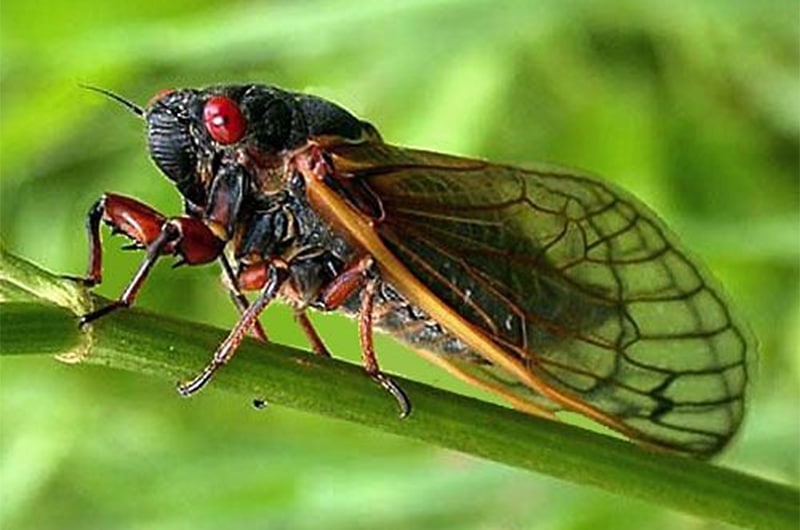~ by Dr. Sarah D. Oktay, Director, University of Massachusetts Nantucket Field Station ~
I was sifting through a bunch of rainfall data trying to wrap my writing around the topic of drought, when the buzz of a cicada reminded me of one of my favorite sounds of the summer. The long wailing buzzing noises coming from the trees can flummox people. I was in Washington DC around July 19 and walking around the Capitol heading to a meeting when cicadas started trilling from the trees; they almost scared the poop out of a lady walking down the street who was obviously distressed hearing them. I told her what they were and that seemed to make her feel better. Knowledge is power, they say.
When I reflect upon a quintessential summer, I think of June bugs, grasshoppers, butterflies, perhaps on more cynical days, deer flies, mosquitoes, wasps…back to good days…fireflies, moths, and as the dog days of summer come, the cicada. For the past three weeks we’ve been able to hear the rasping, buzzing sound of cicadas emanating from trees from downtown to ‘Sconset. Often heard but rarely seen, these harbingers of late summer warm weather days remind us that fall is around the corner. According to folk legend, when you hear the first song of the dog-day cicadas, it means there’s just six weeks until frost. While this may not be a precise predictor, there is some merit to the claim. Dog-day cicadas, as their name implies, appear during the long, hot summer days of late July and August.
Cicadas are insects of the order Hemiptera (“hemi” or “half” + pteron “wing”), in the suborder Auchenorrhyncha and superfamily Cicadoidea, with large eyes wide apart on the head and usually transparent, strongly-veined wings. Hemipteras are “true bugs” whose forewings have a thickened base and membranous tip in many families.
There are about 2,500 species of cicada around the world, and many of them remain unclassified. Cicadas live in temperate to tropical climates where they are among the most widely recognized of all insects, mainly due to their large size and unique sound. Cicadas are a popular protein source and are eaten in China, Malaysia, Burma, Latin America, and the Congo. Cicadas are plant eaters or phytophagous fauna and they are dependent on trees or woody shrubs. Way back in 1930 Charles Willison Johnson published “A List of the Insect Fauna of Nantucket, Massachusetts” in which he stated no cicadas could be found on Nantucket which he attributed to the island’s lack of trees . Over the past several decades, when trees returned to the island, so did the cicadas.
Cicadas range in length from a colossal 110 mm (4.33 inches! including the wings) down to 14 mm. The hind legs of adult cicadas are not modified for jumping. Cicadas have three small eyes, or ocelli, located on the top of the head between the two large eyes. Males of most species (and also females of the Tettigarctidae) have abdominal organs called tymbals, which are used to produce acoustic signals. In addition, unlike most Auchenorrhyncha, members of the family Cicadidae (both males and females) have distinctive sound receptor organs (tympana) on the underside of the abdomen. Nymphs of many cicadas resemble adults in morphology and habits, but lack ocelli (eyes), may have fewer tarsal segments than the adults, and develop wing buds only in their later instars. Cicada nymphs differ from the immatures of other Auchenorrhyncha in having fossorial forelegs (modified for digging) which makes sense since they need to burrow into the soil and hang out there for two to seventeen years.
Hemiptera are different from other insects in that both the nymph and adult forms have a beak (aka rostrum), which they use to suck fluids called xylem from plants. This is how they both eat and drink. Cicada nymphs suck sap from the xylem of various species of tree, including oak, cypress, willow, ash, and maple. Cicadas are sometimes mistakenly called locusts, a term properly used to describe certain migratory grasshoppers. This error originated when early European settlers encountered huge masses of periodical cicadas in the Northeast. As they had not previously seen cicada outbreaks, they likened them to the locusts described in the Bible. Cicadas cannot bite or sting; although they may try to taste you to see if you are a tree if you leave one on your skin long enough!
We often think about cicadas in the “dog days of summer” because many of them start their singing now. The “Dog Days” are named after the period when Sirius (the Dog Star) and the constellation Canis Major begin to appear in the early morning sky. There are about four species of cicadas in Massachusetts. Our local cicadas are typically Neotibicen lyricen lyricen. The genus name for all North American Species has changed recently to Neotibicen from the genus Tibicen. Neotibicen contains most of the larger, louder North American cicada species, which are commonly referred to as the “Dog Day Cicadas.” All are large-bodied with green or orange, brown, and black coloration. Most Neotibicen emerge during mid-to-late summer and have long song phrases, although some have continuous songs, and most prefer deciduous forest trees although a significant minority specialize on southern conifers. A few species extend into Canada and Mexico.
Did you know you can approximately tell the temperature if you hear a cricket sing? I remember this bit of folklore going back (way back) to my childhood, and I was happy to find out that it is true. Crickets are pretty accurate thermometers; you can count the number of chirps in 15 seconds and then add 37 to arrive at an approximate temperature. Cicadas also can gauge the temperature to figure out when to emerge from the soil and for synchronicity and variance in the loudness and syncopation of their songs. Cicadas like heat and do their most spirited singing during the hotter hours of a summer day, in a roughly 24-hour cycle. Scientists have found that their song will vary in pitch and intensity based on temperature cues.
You may recall the recent outburst of the periodical cicadas that inundated the mid-Atlantic States a few years back. These are members of the genus Magicicada. Often when people think of cicadas they are thinking of these periodical cicadas whose long life span and spectacular emergence every 13 or 17 years tends to be a show-stopper. Twelve broods of 17-year cicadas appear in different areas of the northeastern U.S. in different years, emerging from late May through June. Their bright red eyes and reddish markings distinguish the periodical cicadas from the annual or “dog day” cicadas which emerge later in the summer (July through August) and have green markings. That biblical outpouring of periodical adults is a “satiation” strategy which is designed to produce so much “meat on the hoof” that predators like birds or squirrels can’t eat them all which allows cicadas to sing their song and mate in peace.
So who is doing all that singing? As usual, it is the male cicada who is singing his heart out in order to attract a, now slightly deaf, female. Most cicadas have a pair of tymbals or domed, drum-like organs on the sides of the abdomen. They alternately contract and release muscles to make the tymbals resonate. A large air sac in the abdomen with a thin exterior eardrum acts as an echo chamber that greatly amplifies the sound. These muscles do get tired as you may notice when you hear a cicada’s racket taper off. Some cicadas
produce sounds up to 120 dB, among the loudest of all insect-produced sounds. In Costa Rica, cicadas are so loud you often have to stop talking to let them do their thing. I think my husband may start importing those tropical species just for that reason. Some scientists have determined that a cicada is technically loud enough to cause permanent hearing loss in humans, should the cicada sing just outside the listener’s ear. So your deafness might not be a result of that Metallica concert years ago.
A cicada’s high-pitched song not only attracts females (and other males who join in the cacophony) but it also repels birds. In some cases the din is enough to throw off avian communication and disrupt their group hunting behavior. Even cicadas must protect themselves from the volume of their own singing. Males and females have a pair of large, mirror-like membranes called the tympana, which function as ears. The tympana are connected to an auditory organ by a short tendon. When a male sings, the tendon retracts, creasing the tympana so that it won’t be damaged by the sound.
Some tiny cicada species have songs so high in pitch that the noise is inaudible to humans. Every species of cicada has a unique call to ensure they attract the appropriate mate. It can be difficult to determine from which direction(s) cicada song is coming, because the low pitch carries well and because it may, in fact, be coming from many directions at once, as cicadas in various trees often will sing in unison. Females can make a clicking noise with their wings, but it’s nothing like the noise the males make (ain’t that the truth). In addition to the mating song, many species also have a distinct distress call, usually a somewhat broken and erratic sound emitted when an individual is seized. A number of species also have a courtship song, which is often a quieter, Barry White type melody produced after a female has been drawn by the calling song.
After mating, the female woodland cicadas use their specially modified ovipositors to cut short slits in the twigs of the trees they are in. They lay their eggs in the slits and the young nymphs drop to the ground when they hatch. The nymphs burrow underground and spend the next two to five years feeding on plant roots. When they are ready to become adults, and if the soil temperature is just right, the nymphs tunnel to the surface and crawl up on the side of the nearest object. Then the skin splits down the middle of their back and they emerge to inflate and dry their wings, gradually pumping blood throughout their bodies to harden their exoskeleton. This is usually done at night. Adults are present for about four to six weeks following emergence. After mating, females lay eggs in bark or twigs and the cycle starts again.
Cicadas are important in the food chain and are commonly eaten by birds, and sometimes by squirrels, but Massospora cicadina (a fungal disease) is the biggest enemy of cicadas. Another known predator is the cicada killer wasp, which as the name suggests, have evolved simply to feed on one creature. When they’re underground they’re often eaten by moles and other furry insectivores, but enough of them escape the moles to survive. Cicadas can survive freezing temperatures underground. But they only emerge when the soil is warm, typically a relatively toasty 64 degrees Fahrenheit. So they are nature’s thermometers in the sense that they are broadcasting the soil temperature. It has to be relatively warm to reach 63- 66 degrees Fahrenheit at a depth of 20 cm in the soil. When it gets that warm, the cicada nymphs began to emerge. In some of our cities and suburbs, fewer cicadas are seen due to a combination of factors like tree removal, pesticide use, and construction.
You can lose a day or twelve reading about cicadas. I got the name of this column from cicadamania.com, which is a treasure trove of cicada songs, pictures and general nuttiness.



